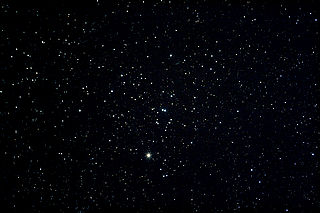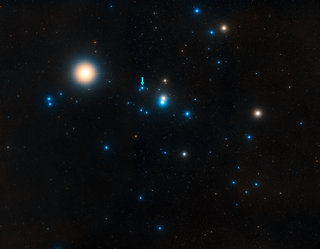Related Research Articles

The Hyades is the nearest open cluster and one of the best-studied star clusters. Located about 153 light-years away from the Sun, it consists of a roughly spherical group of hundreds of stars sharing the same age, place of origin, chemical characteristics, and motion through space. From the perspective of observers on Earth, the Hyades Cluster appears in the constellation Taurus, where its brightest stars form a "V" shape along with the still-brighter Aldebaran. However, Aldebaran is unrelated to the Hyades, as it is located much closer to Earth and merely happens to lie along the same line of sight.

Horologium is a constellation of six stars faintly visible in the southern celestial hemisphere. It was first described by the French astronomer Nicolas-Louis de Lacaille in 1756 and visualized by him as a clock with a pendulum and a second hand. In 1922 the constellation was redefined by the International Astronomical Union (IAU) as a region of the celestial sphere containing Lacaille's stars, and has since been an IAU designated constellation. Horologium's associated region is wholly visible to observers south of 23°N.

Iota Horologii, Latinized from ι Horologii, is a yellow-hued star approximately 56.5 light-years away in the Horologium constellation. The star is classified as a G0Vp yellow dwarf. It has a mass and radius larger than the Sun, and is about 50% more luminous.
Upsilon Serpentis, Latinized from υ Serpentis, is a star in the Serpens Caput section of the constellation Serpens. Based upon an annual parallax shift of 13.04 mas as seen from Earth, it is located around 250 light years from the Sun. The star is bright enough to be faintly visible to the naked eye, having an apparent visual magnitude of +5.70. It is a member of the Hyades group, a stream of stars that share a similar trajectory to the Hyades cluster.

Iota Tauri, Latinized from ι Tauri, is a white-hued star in the zodiac constellation Taurus and an outlying member of the Hyades star cluster. It is visible to the naked eye with an apparent visual magnitude of 4.62, and is located at an estimated distance of about 173 light years based upon parallax measurements. The star is moving away from the Sun with a radial velocity of +38 km/s.

Rho Tauri is a star in the constellation Taurus and a member of the Hyades star cluster.

Sigma Tauri is the Bayer designation for a pair of white-hued stars in the zodiac constellation of Taurus. The system is a visual double star, whose components are designated σ1 Tauri and σ2 Tauri, with the latter being the more northerly star. The two are separated by 7.2 arcminutes on the sky and can be readily split with a pair of binoculars. They have apparent visual magnitudes of +5.07 and +4.70, respectively, which indicated they are both visible to the naked eye. Based upon parallax measurements, σ1 Tauri is about 147 light years from the Sun, while σ2 Tauri is 156 light years distant.

Delta2 Tauri is a solitary, white-hued star in the zodiac constellation of Taurus. Based upon an annual parallax shift of 20.21 mas as seen from Earth, it is located roughly 161 light years distant from the Sun. It is separated from δ1 Tauri by 0.3° on the sky and is faintly visible to the naked eye with an apparent visual magnitude of +4.80. The star is considered a member of the Hyades cluster.

Delta3 Tauri is a binary star system in the zodiac constellation of Taurus. Based upon an annual parallax shift of 21.96 mas as seen from Earth, it is located roughly 149 light years distant from the Sun. It is visible to the naked eye with a combined apparent visual magnitude of +4.32. δ3 Tauri is separated from δ1 Tauri by 0.72° on the sky. This star also has the traditional Latin name Cleeia, from the Greek Kleeia, who was one of the Hyades sisters. It is considered a member of the Hyades cluster.
3 Cancri is a single star in the zodiac constellation of Cancer, located around 810 light years from the Sun. It is visible to the naked eye as a dim, orange-hued star with an apparent visual magnitude of 5.60. This object is moving further from the Earth with a heliocentric radial velocity of +39.5 km/s, and may be a member of the Hyades group. It is located near the ecliptic and thus is subject to lunar eclipses.

71 Tauri is a suspected triple star system in the zodiac constellation Taurus, located 146 light years from the Sun. It is visible to the naked eye as a faint, yellow-white hued star with an apparent visual magnitude of +4.48. The star is moving further away from the Earth with a heliocentric radial velocity of +38 km/s. It is a member of the Hyades open cluster.

HD 128333 or CH Boötis is an irregular variable star in the northern constellation of Boötes. It is currently on the asymptotic giant branch of the HR diagram.
The Hercules stream is a large moving group of stars that are trailing behind the local rate of galactic rotation and are heading further out in the disk relative to the galactic core. Members of this stream may sometimes be referred to as Hercules stars. This stream was first hypothesized to be the remnants of a cluster of stars that has evaporated over time, becoming gravitationally unbound. Alternatively, the Hercules stream may have been created as a resonant effect of the galactic bar at the center of the Milky Way. This stream of stars has a space velocity component V equal to about −40 km/s.
φ Eridani is a star in the constellation Eridanus. It is visible to the naked eye with an apparent visual magnitude of 3.55. The distance to this star, as determined using the parallax method, is around 154 light-years.
Kappa1 Lupi is a solitary star in the southern constellation of Lupus. It is visible to the naked eye with an apparent visual magnitude of 3.86, and forms a double star with Kappa2 Lupi. Based upon an annual parallax shift of 18.12 mas as seen from Earth, it is located about 180 light years from the Sun. Both Kappa1 Lupi and its neighbor Kappa2 Lupi are members of the Hyades Stream, which is a moving group that is coincident with the proper motions of the Hyades cluster.
90 Tauri is a star in the zodiac constellation of Taurus, located 144 light-years away from the Sun. It is visible to the naked eye as a faint, white-hued star with an apparent visual magnitude of 4.27. 90 Tauri is a member of the Hyades cluster and is listed as a double star.

HD 28527 is a star in the constellation Taurus, and a member of the Hyades open cluster. It is faintly visible to the naked eye with an apparent visual magnitude of 4.78. The distance to this star, as determined from its parallax shift of 22 mas, is 148 light years. It is moving away from the Earth with a heliocentric radial velocity of +38 km/s.
ι2 Muscae, Latinised as Iota2 Muscae, is a blue-white-hued star in the southern constellation Musca, near the souther constellation border with Chamaeleon. It has an apparent visual magnitude of 6.62, which is just below the normal limit of stellar brightness visible to the naked eye. Based upon parallax measurements, it is located around 508 light-years from the Sun. It is a member of the Hyades Stream, but is not part of the Hyades or Praesepe open clusters.
ζ Fornacis is the Bayer designation for a star in the southern constellation of Fornax. It is faintly visible to the naked eye with an apparent visual magnitude of 5.67. Based upon a measured annual parallax shift of 29.9 mas, it is located at a distance of about 109 light-years from the Sun. The star is drifting further away with a radial velocity of +29 km/s. Positioned about 1.3° to the southeast of Zeta Fornacis is the galaxy NGC 1232.
HD 75171, also known as HR 3495, is a solitary, white hued star located in the southern constellation of Volans. It has an apparent magnitude of 6.02, making it faintly visible to the naked eye under ideal conditions. The object is relatively close at a distance of 191 light years but is receding with a heliocentric radial velocity of 10.7 km/s. Eggen (1995) lists it as a probable member of the Hyades Supercluster.
References
- ↑ Zuckerman, B; Song, Inseok (2004). "Young Stars Near the Sun". Annual Review of Astronomy and Astrophysics. 42 (1): 685. Bibcode:2004ARA&A..42..685Z. doi:10.1146/annurev.astro.42.053102.134111.
- ↑ Eggen, O. J (1958). "Stellar groups. I. The Hyades and Sirius groups". Monthly Notices of the Royal Astronomical Society. 118: 65–79. Bibcode:1958MNRAS.118...65E. doi: 10.1093/mnras/118.1.65 .
- ↑ Boss, Lewis J (1908). "Convergent of a moving cluster in Taurus". The Astronomical Journal. 26: 31. Bibcode:1908AJ.....26...31B. doi:10.1086/103802.
- ↑ Famaey, B; Pont, F; Luri, X; Udry, S; Mayor, M; Jorissen, A (2007). "The Hyades stream: An evaporated cluster or an intrusion from the inner disk?". Astronomy and Astrophysics. 461 (3): 957–962. arXiv: astro-ph/0609785 . Bibcode:2007A&A...461..957F. doi:10.1051/0004-6361:20065706. S2CID 18072598.
- ↑ Vauclair, S.; Laymand, M.; Bouchy, F.; Vauclair, G.; Hui Bon Hoa, A.; Charpinet, S.; Bazot, M. (2008). "The exoplanet-host star iota Horologii: an evaporated member of the primordial Hyades cluster". Astronomy and Astrophysics. 482 (2): L5–L8. arXiv: 0803.2029 . Bibcode:2008A&A...482L...5V. doi:10.1051/0004-6361:20079342. S2CID 18047352., announced in Emily Baldwin. "The Drifting Star". Archived from the original on 2008-04-21. Retrieved 2008-04-18.